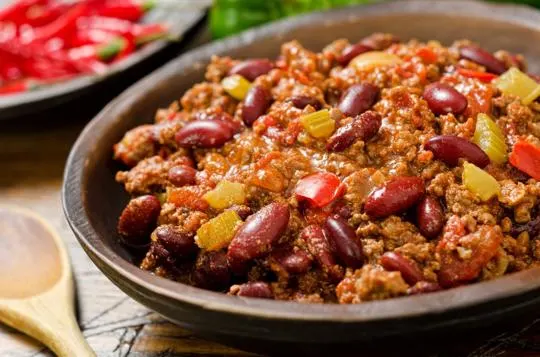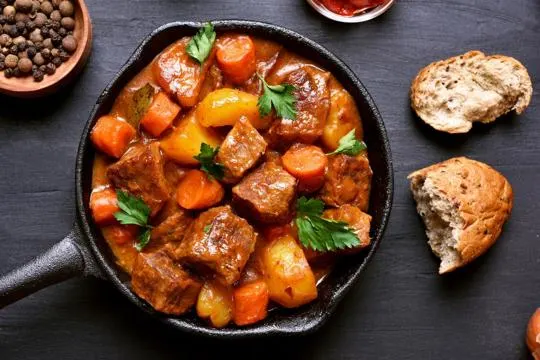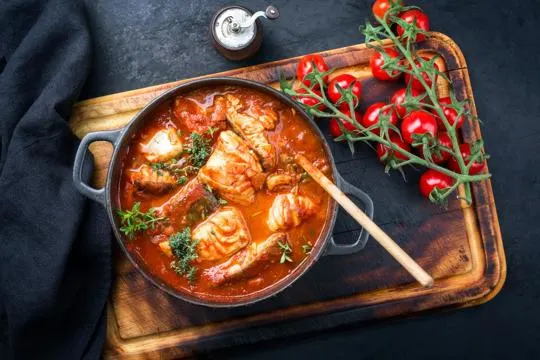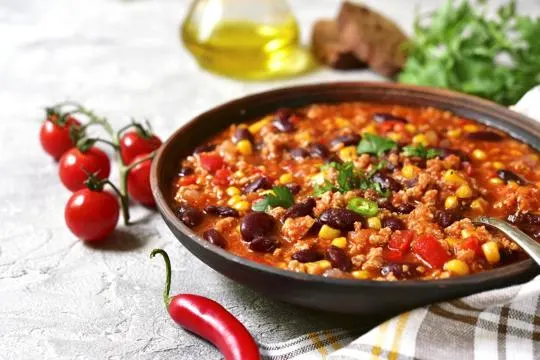Summary of key points
The main difference between chili and stew lies in their ingredients and cooking methods. Chili is typically made with ground or cubed meat, beans, and spices, while stew often includes larger chunks of meat and vegetables cooked in a liquid base.
In terms of flavor, chili tends to have a stronger kick due to the use of chili powder or hot peppers, while stew can have a more mellow and savory taste. Both are hearty and comforting dishes, perfect for colder weather or a cozy night in.
In terms of cooking, chili and stew can both be made on the stovetop or in a slow cooker.
Chili and stew sit in the same family dinner tree, right? They both warm you up, fill you up, and sometimes confuse you. What really sets them apart?
We’ve all been there. Scooping a spoonful, expecting one and getting the other. Chili packs heat with spices and beans. Stew, on the other hand, is like the mild-mannered cousin. It’s all about slow simmering to blend those flavors.
Here’s our quirky take on this kitchen conundrum. We promise, no fancy chef jargon. Just the straight scoop, served with a side of humor. Have you ever mistaken one for the other? We sure have.
What is Chili?

Chili is a scrumptious mix of flavors.
It’s from Mexican cuisine and usually made with ground meat, tomatoes, beans, and various herbs and spices.
Its taste is bold and fiery. Chili can be tailored to anyone’s taste.
Meat can be replaced with veggies or plant-based alternatives.
The type of beans used can vary too. This makes for lots of chili recipes.
It’s also become a regional dish.
Texas-style chili leaves out the beans, while Cincinnati chili has cocoa and cinnamon.
Debates about what makes chili “authentic” rage on.
One thing’s for sure: chili is a beloved favorite.
Eaten alone or with toppings like cheese, sour cream, or onions, it’s guaranteed to tantalize your taste buds.
What is Stew?

Stew – a delectable dish made by simmering meat, veggies, and seasonings in liquid – has been around for centuries.
Its slow-cooking technique unlocks the flavors to create a thick, hearty consistency.
Every ingredient brings its own unique flavor profile to the stew – from herbs and spices to red wine for braising.
This comfort food is highly versatile and can be customized with any ingredients available.
Traditional beef stews, seafood chowders, vegetable medleys – the possibilities are endless.
Plus, there are so many variations – from classic family recipes to contemporary twists with global flavors.
Enjoying this beloved dish has never been easier.
Differences Between Chili and Stew

Chili and stew – not quite the same.
Ingredients Used
Ingredients are decisive for chili and stew.
What separates these two wholesome dishes is the ingredients, providing different flavors and textures for different culinary likes.
Chili often contains ground or cubed meat, like beef or pork.
Plus, spices like chili powder, cumin, and paprika.
Usually, onions, garlic, and tomatoes are added too, making a flavorful base.
Other ingredients might be beans, bell peppers, or even beer, creating a thick, spicy dish.
Stew focuses more on slow-cooked tenderness and comforting flavors.
It usually has larger pieces of meat, like chunks of beef or chicken thighs.
To get the right flavor, you need to simmer the meat slowly with veggies like carrots, potatoes, celery, and onions.
Broth or stock is also necessary to coat all the ingredients as they cook together.
Stews normally have a heartier texture, with the meat falling apart easily.
Chili and stew are warm and comforting, but it’s the ingredients that make them distinct.
So when you’re deciding between the punchy spiciness of chili or the succulent goodness of stew, it’s all about picking the right ingredients to tantalize your taste buds.
Cooking Method and Duration
Cooking methods and time make chili and stew different.
Chili needs less cooking, usually 1-2 hours.
On the other hand, stew takes longer, often 2-4 hours or more.
This lets flavors mix and become richer.
Stew generally requires browning the meat before cooking, while chili relies on spices and aromatics.
These variations in cooking methods and durations are what give chili and stew their unique tastes.
Texture and Consistency
Chili & stew have distinct differences in their texture & consistency.
Both provide a comforting warmth, yet their mouthfeel is notably different.
Chili is known for its spiciness & robust flavors. It has a thick & hearty texture.
Meat, beans & vegetables are cooked until tender, creating a chunky consistency.
Each spoonful offers a satisfying chewiness, balanced by the smoothness of the broth or sauce.
Stew has a velvety texture. Ingredients simmer slowly, allowing them to meld together.
The result? Tender meat & soft, melt-in-your-mouth vegetables.
The thick sauce coats every ingredient.
Chili has bigger chunks of ingredients compared to stew.
Stew includes smaller pieces of meat & veggies, giving it a homogenous texture.
Chili can also be made with ground meat or steak, adding another level of complexity.
In conclusion, chili & stew offer warmth & comfort on cold days.
Chili has a thick & hearty texture with chunky ingredients.
Stew delights with its rich velvety texture & flavors that blend in a delectable symphony.
Flavor Profile and Spice Level
Chili and stew may seem similar, but their flavor profiles and spice levels make them distinctive.
Chili is well-known for its fiery taste, packed with spices like chili powder, cumin, and paprika.
It can bring a burst of heat ranging from mild to very spicy.
Stew, however, offers a more subtle and comforting flavor.
It focuses on herbs like thyme and rosemary to enhance the richness of the meat or vegetables.
This results in a warming and hearty dish without intense spice.
What sets these two dishes apart is how they balance flavors while pleasing different tastes.
Chili fans love the complexity of spices that give each bite a kick.
The mixture of chili peppers, garlic, onions, and spices create a harmonious blend that lingers.
Each ingredient plays an important part in forming flavor layers.
Stew, on the other hand, strives to create a well-rounded taste.
While it doesn’t have the same intensity as chili, it offers a comforting mix of flavors great for those seeking warmth and satisfaction.
The slow-cooking process allows the ingredients to soften and release their natural juices, creating a savory combination.
Chili and stew differ in their flavor profiles and spice levels, yet both are cherished comfort foods worldwide.
Whether you crave the bold kick of chili or yearn for the nourishing embrace of stew, these dishes are sure to tantalize your taste buds and warm your soul with their unique personalities.
So next time you’re stuck between chili or stew, savor their special delights; each has its own magic to be enjoyed.
Similarities Between Chili and Stew

Chili and stew share many common traits, such as their hearty, slow-cooked nature.
Both are made with a blend of meat, veggies, and spices.
Plus, they are both customizable to fit your taste.
Ingredients like beef or chicken are common in both dishes.
Plus, veggies like onions, carrots, tomatoes, and beans can enhance the flavors.
Garlic, cumin, and paprika add depth.
Low heat and slow cooking create a flavor-filled, melt-in-your-mouth texture.
It also ensures that every ingredient is infused with flavor.
Chili and stew are popular during cold months or when you want a comforting meal.
They provide nourishment and a sense of warmth and contentment.
Regardless of culture or tradition, chili and stew have many similarities.
Heartiness, flexibility, slow-cooking, and comfort are some of them.
Variations and Regional Differences in Chili and Stew
Chili and stew have their differences.
They differ in ingredients, cooking methods, and culture.
Both are great for cold winter nights or cozy gatherings.
Chili has a spicier kick with chili powder or peppers.
Stew is known for its rich and savory flavors that come from slow-cooking meat and veggies in a thick broth.
Chili usually has ground or cubed meat, beans, tomatoes, onions, and spices.
It’s often topped with cheese, sour cream, and onions.
Stews can have a wide range of protein like beef, lamb, or poultry.
Carrots, potatoes, and celery are also common.
Regions make a difference in chili and stew.
Texas-style chili is spicy with no beans.
Cincinnati-style chili incorporates cinnamon and cocoa powder.
Irish stew has root veggies and Hungarian goulash has paprika.
We can appreciate different cultures’ spins on these comfort foods.
So if you like chili’s fiery kick or stew’s comforting warmth, there’s no denying that both are beloved across regions.
When to Choose Chili and When to Choose Stew?
Choosing between chili and stew?
Think about the flavors and cooking techniques.
Chili usually has more spice due to chili powder and other spices.
Ground or cubed meat, beans, and veggies make up chili.
Stew has a milder taste. Larger chunks of meat (beef or lamb) with veggies and broth comprise a stew.
Both are great for cold weather.
Chili is for those who love hot and bold flavors. Stew is more gentle and savory.
Conclusion
All in all, chili and stew are two wonderful creations with their own unique differences.
Chili is a Tex-Mex classic that usually contains beef paired with spicy chilies, beans, and tomatoes.
Stew is a one pot or crockpot dinner composed of various vegetables, proteins, water, and salt.
While I still don’t think we have settled the great debate of which dish is superior, there’s no denying that both hold an important place on the table.
In my opinion, eating either one is always encouraged – giving us all another delicious way to experiment in the kitchen and enjoy a good meal.
So next time you’re looking for something tasty to make for dinner, why not try out chili or stew? It’s sure to keep you full of flavor and satisfaction.

Leave a comment